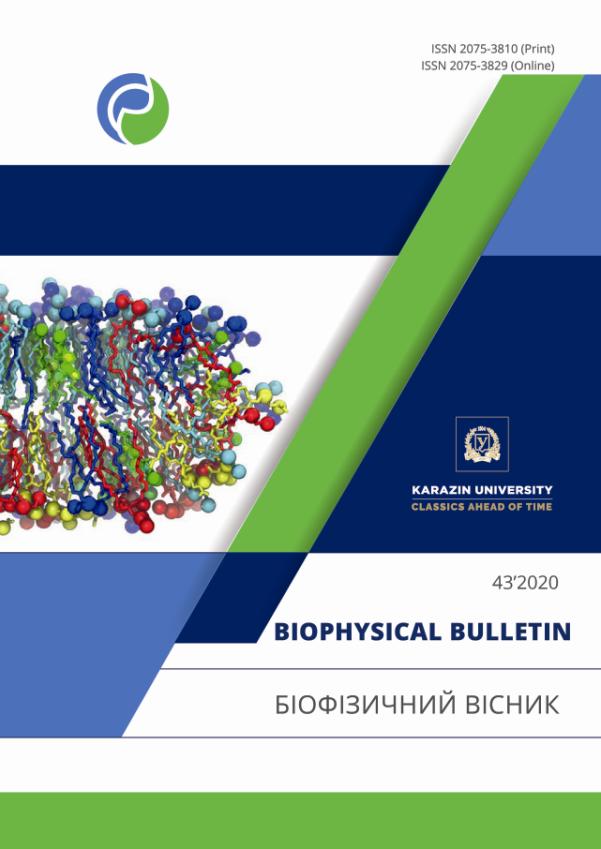Fluorescence of molecular composites that consist of nematic liquid crystal and merocyanins
Abstract
Background: Considered merocyanine molecules have donor D and acceptor A moieties connected by polymer chain. The conjugated donor D and acceptor A parts of merocyanine molecules are planar in the ground state. The D-π-A molecular complexes can change their conformations in an excited state due to cis-trans-conformational transitions. The viscosity of the solvent affects conformational changes, photoluminescence (PL) decay and PL lifetime. Therefore the PL of merocyanine molecules strongly depends on medium in excited and ground states. A nematic liquid crystal was utilized as a solvent for merocyanine molecules since it is characterized by long range order, orientates merocyanine molecules along its axis and is sensitive to external electro-magnetic field. The molecules with conjugated donor D and acceptor A parts are promising for molecular electronics (instruments for recording and processing information), optoelectronics (laser technologies) and biological research (fluorescent probes like prominent thioflavin T), since their PL essentially depends on the nature of the environment.
Objectives: The main objective of this paper is to investigate and explain impact of liquid crystal medium on considered molecules. Also influence of molecular conformational changes on their spectral properties is considered.
Materials and Methods: Two types of merocyanine molecules M-1 and M-2 were investigated. The spectral properties of molecules in different organic solvents such as acetonitrile, toluene, glycerol, and in 4-pentyl-4′-cyanobiphenyl (5CB) liquid crystal were compared. Stationary and time-resolved emission spectra of molecular merocyanine solutions were used to investigate conformational changes of molecules. To determine a lifetime of molecular excited states, a technique of Time Correlated Single Photon Counting with picosecond resolution in time was used.
Results: The results indicate that optical properties strongly depend on conformation of conjugated donor-π-acceptor compounds. A relaxation of dye molecules to the ground state is accompanied by conformational changes. The quantum yield and lifetime of PL increase in more viscous solvents. The liquid crystal made conformational changes of considered molecules in ground and excited states.
Conclusions: Analysis of the results serves as a basis for constructing a theory that explains properties of D-π-A molecular compounds under optical excitation. The molecular pairs are formed by merocyanine and liquid crystal molecules. The liquid crystal molecule defines conformation of merocyanine molecule in a pair. Moreover, both types of merocyanine molecules in liquid crystal have the same conformation. This hypothesis explains similarities of optical properties of M-1 and M-2 molecules in liquid crystal.
Downloads
References
Sevryukova MM, Piryatinski YuP, Vasylyuk SV, Yashchuk VM, Viniychuk OO, Gerasov AO, et al. Cyanine-like and polyenic relaxation paths of merocyanine derivatives of malonodinitrile in the excited state detecting by low temperature time-resolved fluorescence. Ukr J Phys. 2012;57(8):812–23.
Maskevich AA, Stsiapura VI, Kuzmitsky VA, Kuznetsova IM, Povarova OI, Uversky VN, et al. Spectral properties of thioflavin T in solvents with different dielectric properties and in a fibril-incorporated form. J Proteome Res. 2007;6(4):1392–401. https://doi.org/10.1021/pr0605567
Stsiapura VI, Maskevich AA, Kuzmitsky VA, Turoverov KK, Kuznetsova IM. Computational study of thioflavin T torsional relaxation in the excited state. J Phys Chem A. 2007;111(22):4829–35. https://doi.org/10.1021/jp070590o
Lisetski LN, Zavora LN, Kasian NA, Vashchenko OV, Panikarskaya VD. Cholesteric liquid crystals doped with molecules of organic scintillator materials. Mol Cryst Liq Cryst. 2009;510(1):106–15. https://doi.org/10.1080/15421400903058692
Piryatinski YuP, Sevryukova MM. Optical properties of π-conjugated donor-acceptor systems with controlled hyperpolarizability. Semiconductor Physics, Quantum Electronics and Optoelectronics. 2008;11(3):292–302.
Lemke R. Solvatochromie von 80 mμ in verschiedenen Alkoholen bei Arylidenisophoron-Abkömmlingen [80 mμ-Solvatochromy of Arylidenisophoron Derivatives in Different Alcohols]. Chemische Berichte. 1970;103(6):1894–9. [In German]. https://doi.org/10.1002/cber.19701030628
Lemke R. Knoevenagel-Kondensationen in Dimethylformamid [Knoevenagel condensations in dimethylformamide]. Synthesis. 1974;1974(5):359–61. [In German]. https://doi.org/10.1055/s-1974-23322
Sevryukova M, Piryatinski YuP. Dynamics of transfer of electron excitation in a donor-acceptor system with a carbon chain and ways of its relaxation. Semiconductor Physics Quantum Electronics and Optoelectronics. 2017 Jul;20(4):406–17. https://doi.org/10.15407/spqeo20.04.406
Fabian J, Zahradnic R. MO-LCAO calculations on polymethines. 6. PPP calculations on the vinylene shift of symmetric dyes. Wiss Z Tech Univ (Dresden). 1977;26:315–23.
Lutsyk P, Piryatinski Y, Kachkovsky O, Verbitsky A, Rozhin A. Unsymmetrical relaxation paths of the excited states in cyanine dyes detected by time-resolved fluorescence: polymethinic and polyenic forms. J Phys Chem A. 2017;121(43):8236–46. https://doi.org/10.1021/acs.jpca.7b08680
David C, Baeyens-Volant D. Absorption and fluorescence spectra of 4-cyanobiphenyl and 4-alkyl- or 4-alkoxy-substituted liquid crystalline derivatives. Mol Cryst Liq Cryst. 1980;59(3–4):181–96. https://doi.org/10.1080/00268948008071422
Piryatinskiĭ YP, Yaroshchuk OV. Photoluminescence of pentyl-cyanobiphenyl in liquid-crystal and solid-crystal states. Optics and Spectroscopy. 2000;89(6):860–6. https://doi.org/10.1134/1.1335034
Petrov VF, Grebenkin MF, Ostrovskij BIC. Issledovanie struktury nematicheskoj fazy cyanoproizvodnykh piridina metodom rasseyaniya renthenovskih luchey [Study of the structure of the nematic phase of cyanide pyridine by X-ray scattering]. Kristallografiya. 1988;33(5):1194–201.
Piryatinskiĭ YP, Yaroshchuk OV. Orientation of pentyl-cyanobiphenyl layers and variations in their luminescence spectra under UV irradiation. Optics and Spectroscopy. 2002;92(4):517–23. https://doi.org/10.1134/1.1473590
Authors who publish with this journal agree to the following terms:
- Authors retain copyright and grant the journal right of first publication with the work simultaneously licensed under a Creative Commons Attribution License that allows others to share the work with an acknowledgement of the work's authorship and initial publication in this journal.
- Authors are able to enter into separate, additional contractual arrangements for the non-exclusive distribution of the journal's published version of the work (e.g., post it to an institutional repository or publish it in a book), with an acknowledgement of its initial publication in this journal.
- Authors are permitted and encouraged to post their work online (e.g., in institutional repositories or on their website) prior to and during the submission process, as it can lead to productive exchanges, as well as earlier and greater citation of published work (See The Effect of Open Access).





